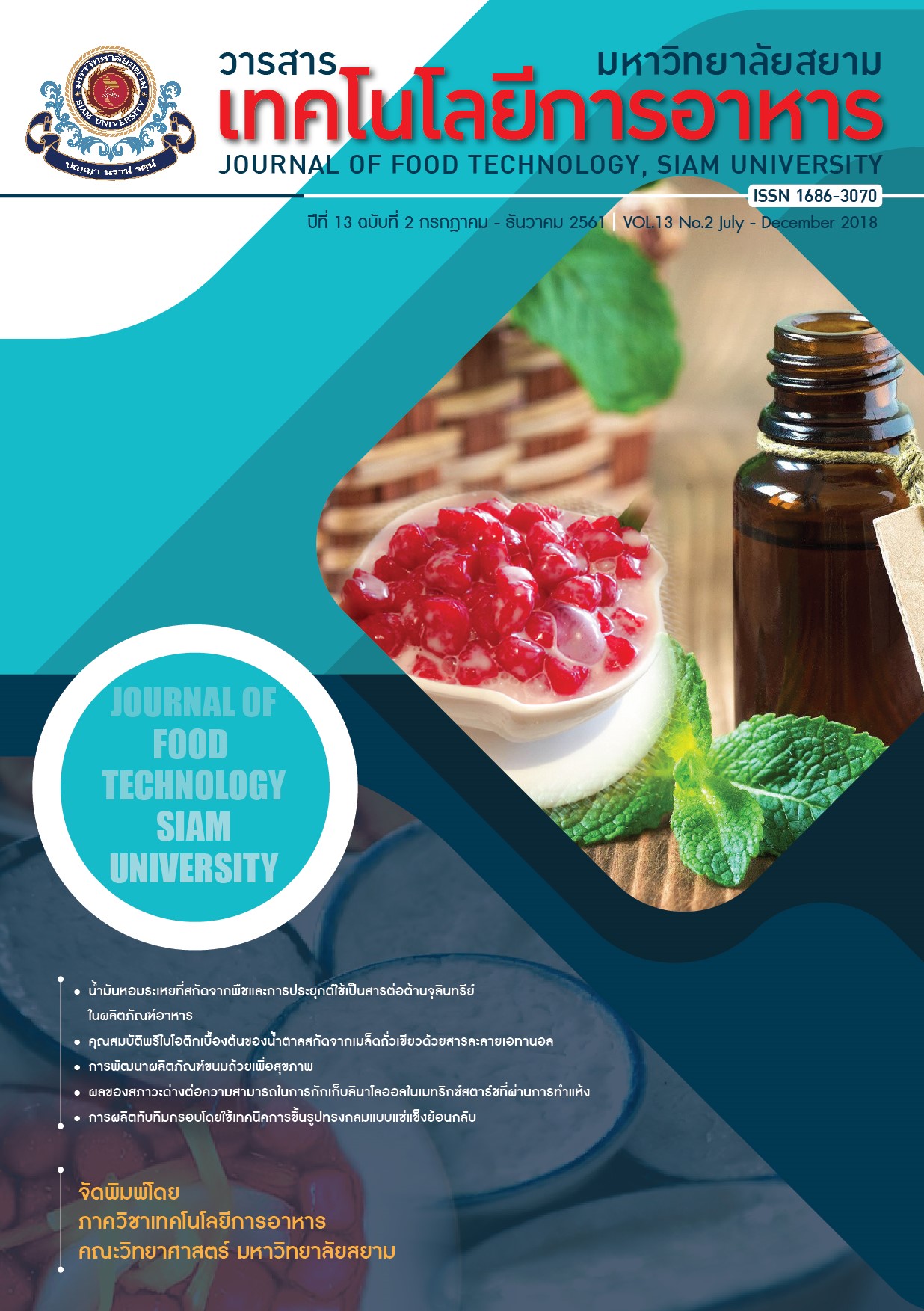Development of Kanomtuay Product for Health
Main Article Content
Abstract
This research aimed to optimize the ingredients to produce lower and upper layers of a healthy Thai dessert called “kanomtuay”. The nine formulations of the lower layer of the dessert consisting of water, sugar and fresh longan flesh were studied by using Mixture Design. Sensory evaluation was conducted by 30 untrained panelists. It was found that a suitable formulation of the lower layer was 17.5% water, 22.5% sugar and 60% fresh longan flesh. This formulation had the highest score of taste, texture and overall liking (7.80±0.66). Furthermore, the suitable ratio of coconut milk substituted by soy milk in the upper layer of kanomtuay was studied. Coconut milk was replaced by soy milk at 0, 25, 50, 75 and 100%. The result indicated that 50% substitution with soy milk showed a good appearance of kanomtuay. The upper layer had canary yellow color, moderately oily fracture and soft texture. Moreover, there was no separation between lower and upper layer of kanomtuay. It had overall liking score of 7.23±0.63 (like moderately). Interestingly, low temperature (4°C) can extend the shelf life of kanomtuay for seven days. Meanwhile, the sample was spoiled at room temperature (30°C) during storage in two days. In conclusion, the healthy kanomtuay product is a new interesting alternative for consumers.
Article Details
Copyrights of all articles in the Journal of Food Technology available in print or online are owned by Siam University and protected by law.
References
[2] Kusump, S. Maneesilasun, N. and Wonganutthara, V. (2011). Substitution of soy protein isolate for non fat dry milk in low fat ice cream. Thai Journal of Science and Technology. 19(1): 48-59.
[3] Plant varieties protection office. (2017). Longan. [Online] Available from https://www.doa.go.th/pvp/images/stories/top03_doc_vichakarn/longan.pdf [Accessed April, 17, 2018]
[4] Soong, Y.Y.and Barlow, P.J. (2006). Quantification of gallic acid and ellagic acid from longan seed and mango kernel and their effects on antioxidant activity. Food Chemistry. 97(3): 524-530.
[5] Rangkadilok, N., Worasuttayayangkurn, L., Bennett, R. and Satayavivad, J. (2005). Identification and quantification of polyphenolic compounds in longan (Euphoria longana Lam.) fruit. Journal of Agricultural and Food Chemistry. 53(5): 1387-1392.
[6] Woo, T.M. and Robinson, M.V. (2016). Pharmacotherapeutics for advanced practice nurse Prescribers. F.A. David Company, Philadelphia, Pennsylvania.
[7] Duncan, D.B. (1995). Multiple range and multiple F tests. Biometrics. 11: 1–42.
[8] Association of Official Analytical Chemists (AOAC International). (2012). Official methods of analysis. 19th ed., Washington, D.C.
[9] Thai industrial standards institute. (2003). Thai community product standard (Thai desserts) 1/2546. [Online] Available from https://app.tisi.go.th/otop/standard/ standards.html. [Accessed October, 16, 2017]
[10] Department of health. (1992). Nutrition information for Thai food. Bureau of nutrition, Department of health, Ministry of public health. [Online] Available from https://nutrition.anamai.moph.go.th. [Accessed September, 18, 2017]
[11] Tangkanakul, P. (2002). Factors affecting the quality of tofu. Food (Thailand). 32(2): 92-97.
[12] Rapporn, C. (2004). Effect of high pressure on physical and sensory properties of soft tofu. Master’s thesis. Songkla: Prince of Songkla University.
[13] Sirison, J. and Puechkamut, Y. (2009). Formulation of imitation pasteurized coconut milk using soybean milk. [Online] Available from https://doi.nrct.go.th// ListDoi/listDetail? Resolve_DOI=10.14457/ KMITL. res.2009.40 [Accessed February, 25, 2018]
[14] Phunchpoon, T. (1994). Fat replacer. Journal of the Department of Science Service. 42: 20-24.
[15] Tubbiyam, P. (2006). Soybean milk supplemented with Job’s tear milk and nata de soya. Master’s thesis. Bangkok: Kasetsart University.
[16] Rattanapanone, N. (2006). Food chemistry. Odeon Store, Bangkok. 504.
[17] Samanurat, M. (2014). Bacterial inhibition of biopreservative producing psychrotrophic lactic acid bacteria. Master’s thesis. Songkla: Prince of Songkla University.
[18] Kongbangkerd, T. (2003). Food Microbiology. Department of Agro-Industry. Naresuan University.

